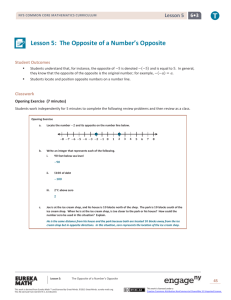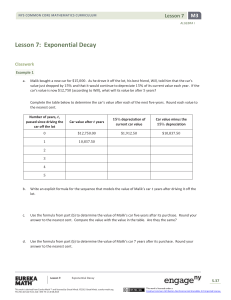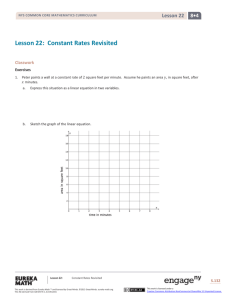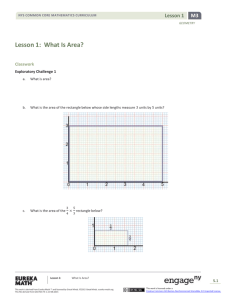Exponents: Multiplication & Division Worksheet
advertisement
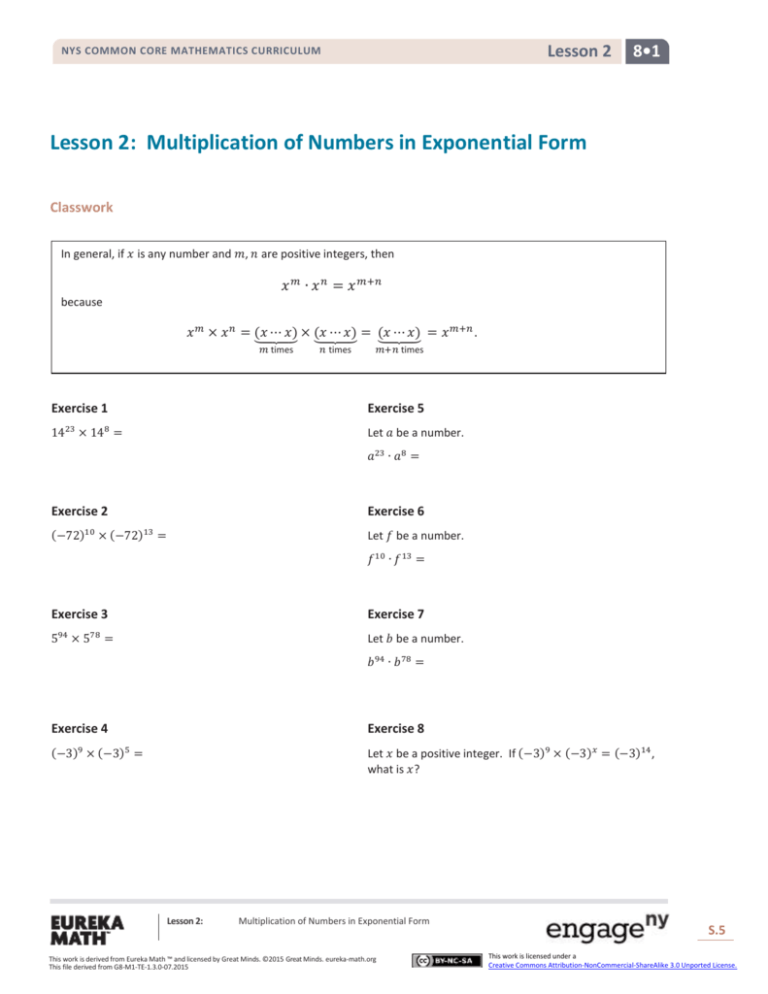
Lesson 2 NYS COMMON CORE MATHEMATICS CURRICULUM 8•1 Lesson 2: Multiplication of Numbers in Exponential Form Classwork In general, if 𝑥 is any number and 𝑚, 𝑛 are positive integers, then 𝑥 𝑚 ∙ 𝑥 𝑛 = 𝑥 𝑚+𝑛 because (𝑥 ⋯ 𝑥) × ⏟ (𝑥 ⋯ 𝑥) = ⏟ (𝑥 ⋯ 𝑥) = 𝑥 𝑚+𝑛 . 𝑥𝑚 × 𝑥𝑛 = ⏟ 𝑚 times 𝑛 times 𝑚+𝑛 times Exercise 1 Exercise 5 1423 × 148 = Let 𝑎 be a number. 𝑎23 ∙ 𝑎8 = Exercise 2 Exercise 6 (−72)10 × (−72)13 = Let 𝑓 be a number. 𝑓 10 ∙ 𝑓 13 = Exercise 3 Exercise 7 594 × 578 = Let 𝑏 be a number. 𝑏 94 ∙ 𝑏 78 = Exercise 4 Exercise 8 (−3)9 × (−3)5 = Let 𝑥 be a positive integer. If (−3)9 × (−3) 𝑥 = (−3)14 , what is 𝑥? Lesson 2: Multiplication of Numbers in Exponential Form This work is derived from Eureka Math ™ and licensed by Great Minds. ©2015 Great Minds. eureka-math.org This file derived from G8-M1-TE-1.3.0-07.2015 S.5 This work is licensed under a Creative Commons Attribution-NonCommercial-ShareAlike 3.0 Unported License. Lesson 2 NYS COMMON CORE MATHEMATICS CURRICULUM 8•1 What would happen if there were more terms with the same base? Write an equivalent expression for each problem. Exercise 9 Exercise 10 94 × 96 × 913 = 23 × 25 × 27 × 29 = Can the following expressions be written in simpler form? If so, write an equivalent expression. If not, explain why not. Exercise 11 Exercise 14 65 × 49 × 43 × 614 = 24 × 82 = 24 × 26 = Exercise 12 Exercise 15 (−4)2 ∙ 175 ∙ (−4)3 ∙ 177 = 37 × 9 = 37 × 32 = Exercise 13 Exercise 16 152 ∙ 72 ∙ 15 ∙ 74 = 54 × 211 = Exercise 17 Let 𝑥 be a number. Rewrite the expression in a simpler form. (2𝑥 3 )(17𝑥 7 ) = Exercise 18 Let 𝑎 and 𝑏 be numbers. Use the distributive law to rewrite the expression in a simpler form. 𝑎(𝑎 + 𝑏) = Lesson 2: Multiplication of Numbers in Exponential Form This work is derived from Eureka Math ™ and licensed by Great Minds. ©2015 Great Minds. eureka-math.org This file derived from G8-M1-TE-1.3.0-07.2015 S.6 This work is licensed under a Creative Commons Attribution-NonCommercial-ShareAlike 3.0 Unported License. Lesson 2 NYS COMMON CORE MATHEMATICS CURRICULUM 8•1 Exercise 19 Let 𝑎 and 𝑏 be numbers. Use the distributive law to rewrite the expression in a simpler form. 𝑏(𝑎 + 𝑏) = Exercise 20 Let 𝑎 and 𝑏 be numbers. Use the distributive law to rewrite the expression in a simpler form. (𝑎 + 𝑏)(𝑎 + 𝑏) = In general, if 𝑥 is nonzero and 𝑚, 𝑛 are positive integers, then 𝑥𝑚 = 𝑥 𝑚−𝑛 . 𝑥𝑛 Exercise 21 Exercise 23 79 = 76 8 9 ( ) 5 = 8 2 ( ) 5 Exercise 22 Exercise 24 (−5)16 = (−5)7 135 = 134 Lesson 2: Multiplication of Numbers in Exponential Form This work is derived from Eureka Math ™ and licensed by Great Minds. ©2015 Great Minds. eureka-math.org This file derived from G8-M1-TE-1.3.0-07.2015 S.7 This work is licensed under a Creative Commons Attribution-NonCommercial-ShareAlike 3.0 Unported License. Lesson 2 NYS COMMON CORE MATHEMATICS CURRICULUM 8•1 Exercise 25 Let 𝑎, 𝑏 be nonzero numbers. What is the following number? 𝑎 9 ( ) 𝑏 = 𝑎 2 ( ) 𝑏 Exercise 26 Let 𝑥 be a nonzero number. What is the following number? 𝑥5 = 𝑥4 Can the following expressions be written in simpler forms? If yes, write an equivalent expression for each problem. If not, explain why not. Exercise 27 Exercise 29 27 2 7 = = 42 2 4 35 ∙ 28 = 32 ∙ 23 Exercise 28 Exercise 30 323 323 = 3 = 27 3 (−2)7 ∙ 955 = (−2)5 ∙ 954 Lesson 2: Multiplication of Numbers in Exponential Form This work is derived from Eureka Math ™ and licensed by Great Minds. ©2015 Great Minds. eureka-math.org This file derived from G8-M1-TE-1.3.0-07.2015 S.8 This work is licensed under a Creative Commons Attribution-NonCommercial-ShareAlike 3.0 Unported License. NYS COMMON CORE MATHEMATICS CURRICULUM Lesson 2 8•1 Exercise 31 Let 𝑥 be a number. Write each expression in a simpler form. a. b. c. 5 𝑥3 5 𝑥3 5 𝑥3 (3𝑥 8 ) = (−4𝑥 6 ) = (11𝑥 4 ) = Exercise 32 Anne used an online calculator to multiply 2 000 000 000 × 2 000 000 000 000. The answer showed up on the calculator as 4e + 21, as shown below. Is the answer on the calculator correct? How do you know? Lesson 2: Multiplication of Numbers in Exponential Form This work is derived from Eureka Math ™ and licensed by Great Minds. ©2015 Great Minds. eureka-math.org This file derived from G8-M1-TE-1.3.0-07.2015 S.9 This work is licensed under a Creative Commons Attribution-NonCommercial-ShareAlike 3.0 Unported License. Lesson 2 NYS COMMON CORE MATHEMATICS CURRICULUM 8•1 Problem Set 1. 2 A certain ball is dropped from a height of 𝑥 feet. It always bounces up to 𝑥 feet. Suppose the ball is dropped from 3 10 feet and is stopped exactly when it touches the ground after the 30th bounce. What is the total distance traveled by the ball? Express your answer in exponential notation. Bounce Computation of Distance Traveled in Previous Bounce Total Distance Traveled (in feet) 1 2 3 4 30 𝑛 2. If the same ball is dropped from 10 feet and is caught exactly at the highest point after the 25th bounce, what is the total distance traveled by the ball? Use what you learned from the last problem. 3. Let 𝑎 and 𝑏 be numbers and 𝑏 ≠ 0, and let 𝑚 and 𝑛 be positive integers. Write each expression using the fewest number of bases possible: (−19)5 ∙ (−19)11 = 2.75 × 2.73 = 710 = 73 1 2 1 15 ( ) ∙( ) = 5 5 9 𝑚 9 𝑛 (− ) ∙ (− ) = 7 7 𝑎𝑏 3 = 𝑏2 4. Let the dimensions of a rectangle be (4 × (871209)5 + 3 × 49762105) ft. by (7 × (871209)3 − (49762105)4 ) ft. Determine the area of the rectangle. (Hint: You do not need to expand all the powers.) 5. A rectangular area of land is being sold off in smaller pieces. The total area of the land is 215 square miles. The pieces being sold are 83 square miles in size. How many smaller pieces of land can be sold at the stated size? Compute the actual number of pieces. Lesson 2: Multiplication of Numbers in Exponential Form This work is derived from Eureka Math ™ and licensed by Great Minds. ©2015 Great Minds. eureka-math.org This file derived from G8-M1-TE-1.3.0-07.2015 S.10 This work is licensed under a Creative Commons Attribution-NonCommercial-ShareAlike 3.0 Unported License.







